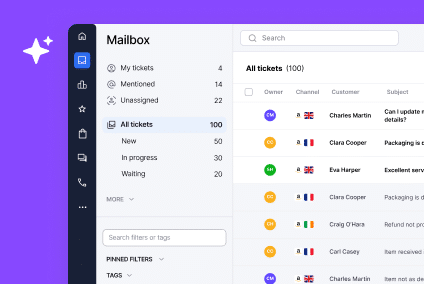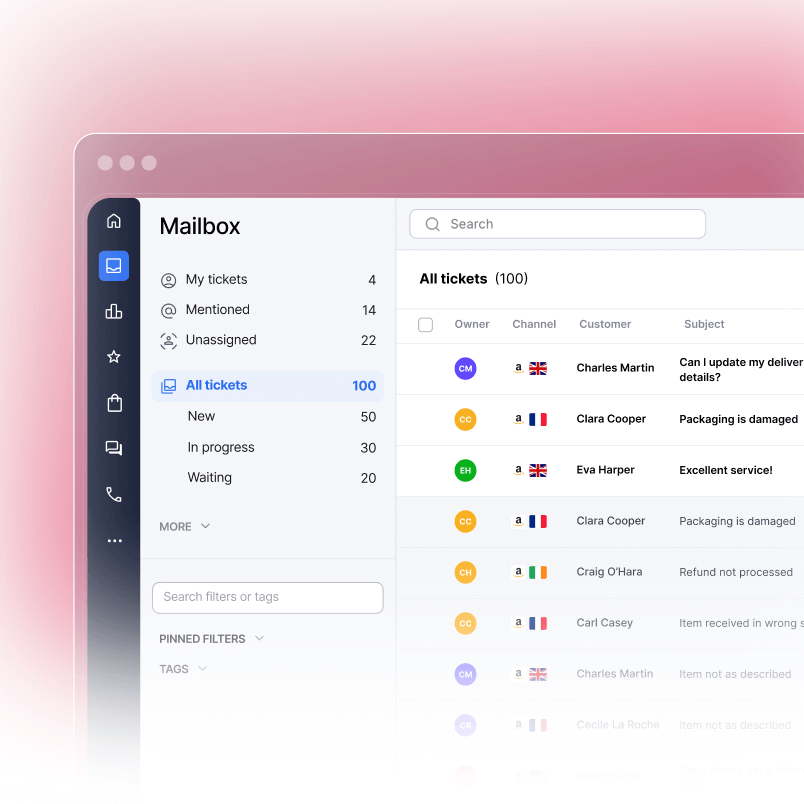Freshdesk works fine for IT support teams and general customer service. But if you sell on Shopify, Amazon, or eBay, you know it falls short. Your team wastes time jumping between Freshdesk and your store platform. Orders don’t sync automatically. Refund requests pile up without smart workflows. This guide shows you what’s missing in Freshdesk for ecommerce and why thousands of online sellers are moving to specialized support platforms built for their workflows.
Why Freshdesk Falls Short for Ecommerce Brands
Freshdesk is a solid general helpdesk. It handles tickets, assigns work, and tracks responses. For restaurants, SaaS companies, or consulting firms, that’s enough.
Ecommerce is different. You need real-time access to order data, inventory status, and customer purchase history. You need to process refunds from within your support interface. You need templates for the 20 questions you get asked every day. Freshdesk doesn’t build for these workflows.
Generic Ticketing That Doesn’t Match Ecommerce Work
Freshdesk treats every ticket the same, whether it’s a billing question or an order status inquiry. It’s designed for IT support workflows, not the specific rhythms of running an online store. When your team gets 500 tickets daily and half of them are «Where’s my order?», you need routing and responses built for that reality.
No Real-Time Order Visibility in Tickets
When a customer emails about their shipment, your agent opens Freshdesk, finds the ticket, then opens Shopify or Amazon to look up the order. That’s wasted seconds on every single ticket. Multiply that by hundreds of daily inquiries and you’re losing hours of productivity weekly.
Poor Native Integrations with Ecommerce Platforms
Freshdesk connects to Shopify and Amazon, but the data doesn’t flow smoothly. Order context doesn’t appear in tickets without extra setup steps. You end up with half-built integrations that create more work than they save.
No Pre-Built Macros for Common Ecommerce Questions
You build a response template for «Where is my order?» but it’s generic. You need one that pulls live tracking info, another for refunds, another for returns. Freshdesk doesn’t understand ecommerce workflows out of the box.
Clunky UI for High-Volume Multichannel Work
Managing support across Instagram, Facebook, Shopify chat, and marketplace messages requires constant tab switching in Freshdesk. Your agents juggle five different windows while customers wait for answers. According to McKinsey’s research on customer service, companies that unify their customer support channels see a 20% improvement in customer satisfaction scores.
Limited CSAT Tracking Tied to Product Data
You can’t easily see which product or order drove negative feedback. You get a score but no path to improvement.
According to G2’s 2024 survey, 34% of ecommerce businesses abandon general helpdesks because they lack multichannel capabilities. The switching costs are real, but staying with the wrong tool costs more in agent frustration and slow response times. Many teams making the switch find that specialized ecommerce solutions drive better CSAT scores and faster resolution times.
What Ecommerce Support Software Does Differently
Ecommerce-native support platforms are purpose-built to solve these problems.
Real-Time Order Data in Every Ticket
When a customer submits a support request, their entire order history, shipping status, and product details populate automatically. Your agent sees the full picture without leaving the support interface. According to Shopify’s customer support best practices guide, having real-time access to customer data reduces average response times by 40% and significantly improves first-contact resolution rates.
Channel-Based Ticket Routing
Emails go to one queue, Shopify chat to another, Instagram DMs to a third. Agents work from one inbox but sort by channel, so response standards stay consistent. Learn more about how best helpdesk apps for Shopify handle multichannel workflows.
Pre-Built Macros for Ecommerce Questions
Instead of writing «Where is your order?» from scratch, you click a macro that inserts tracking info, ships the response, and auto-tags the ticket. Common workflows take seconds, not minutes.
Seamless Refund and Return Workflows
One agent action processes a refund, updates inventory, and sends a confirmation email. No logging into separate systems.
Tag-Based Automation and SLAs
Set rules like: if a customer mentions «damage» and bought your Deluxe Bundle, auto-assign to senior agents and flag for priority response within 2 hours.
CSAT Tracking Tied to Product Data
See which products generate complaints and which agents handle certain types of inquiries best. Use this data to improve training and product quality.
This is the core difference. Ecommerce support tools speak your language because they’re designed inside ecommerce operations.
Top Freshdesk Alternatives for Ecommerce
Gorgias for Shopify-First Brands
Gorgias is built for Shopify sellers. One-click refund macros and native Shopify app store integration make it fast to set up. Deep connections to Meta ads and Klaviyo tie customer support directly to marketing.
Best for: DTC Shopify brands with a focused audience.
Key integrations: Shopify, Meta, Klaviyo, email, chat.
Standout features: One-click refunds, live product data in tickets, built-in email marketing sync.
Re:amaze for Multichannel Retailers
Re:amaze excels when you sell across multiple channels. It combines a shared inbox with live chat, ticketing, and knowledge base tools. Amazon, eBay, Shopify, and WooCommerce all feed into one workspace.
Best for: Sellers on 2+ platforms who need unified support.
Key integrations: Shopify, Amazon, eBay, WooCommerce, email, live chat, social media.
Standout features: Shared inbox with chat, built-in FAQ builder, SLA tracking, bulk operations.
eDesk for Marketplace Sellers
eDesk focuses on Amazon, eBay, and Walmart sellers. It’s built to handle marketplace-specific workflows: feedback management, resolution center requests, bulk messaging, and SLA compliance. For sellers in the marketplace space, this is where specialized agent SLA tracking software and pre-built templates save the most time. eDesk’s approach to marketplace seller support simplifies the repetitive work that consumes hours daily.
Best for: Amazon, eBay, and Walmart sellers managing high volumes.
Key integrations: Amazon, eBay, Walmart, email, bulk actions.
Standout features: Marketplace SLA compliance, feedback management, bulk operations, pre-built templates for common marketplace requests.
Delightchat for Lean Shopify Teams
Delightchat brings WhatsApp, Instagram, and Facebook messaging into one interface. Built for smaller teams that need budget-friendly automation without complexity.
Best for: Lean Shopify teams using social messaging.
Key integrations: WhatsApp, Instagram, Facebook, Shopify.
Standout features: Conversational automation, affordable pricing, simple setup.
Comparison Table
| Platform | Best For | Key Integrations | Standout Feature |
| Gorgias | Shopify-first DTC brands | Shopify, Meta, Klaviyo | One-click refund macros |
| Re:amaze | Multichannel retailers | Shopify, Amazon, eBay, WooCommerce | Shared inbox with chat |
| eDesk | Marketplace sellers | Amazon, eBay, Walmart | Marketplace SLA compliance |
| Delightchat | Lean Shopify teams | WhatsApp, Instagram, Facebook, Shopify | Budget-friendly automation |
Migration Tips: Switching from Freshdesk Smoothly
The good news: switching platforms doesn’t require a service outage or ticket loss.
Export Your Data First
Most helpdesks support bulk exports of contacts, tickets, and custom fields. Freshdesk includes a data export tool. Create backups before you move.
Choose a Platform With Import Support
eDesk, Gorgias, and Re:amaze all have migration guides and can import your contact lists and ticket history. This keeps customer context intact.
Set Up Integrations Before Migrating Tickets
Connect your ecommerce platform (Shopify, Amazon, eBay) to your new tool first. Test that order data flows correctly. This step prevents surprises after you flip the switch. eDesk’s help desk migration support includes integration setup as part of the process, making this transition smooth.
Map Your Most-Used Workflows
Your team likely has 10 to 20 key macros or response templates. Before migration, identify which ones matter most. Rebuild them in your new platform using ecommerce-specific triggers.
Key workflows to rebuild first:
Shipping updates and tracking links with live data.
Refund and return request processes.
Product question responses with inventory status.
Negative feedback workflows.
Run a Parallel Period
Run Freshdesk and your new tool together for a few days. New tickets go to the new platform. Existing Freshdesk tickets stay where they are until resolved. This reduces risk and lets your team get comfortable.
Train Your Team on New Workflows
Ecommerce tools have different UI layouts and automation options. A 30-minute walkthrough on pre-built macros and multichannel routing saves weeks of support delays.
Signs It’s Time to Leave Freshdesk
Your team spends 20 percent of their day toggling between Freshdesk and Shopify. Every ticket requires a context switch.
You get high volume of repetitive tickets about shipping status, order tracking, or refund requests. The same questions come 50 times a day and Freshdesk doesn’t automate responses.
Your CSAT scores are poor despite good agent effort. Slow reply times happen because agents waste time gathering data from multiple systems.
Agents don’t have real-time customer or order data. They write generic responses because they can’t see the full picture in one view.
Your team avoids using the helpdesk for chat and social messages. They handle DMs and live chat in separate tools and Freshdesk becomes a dumping ground for formal support requests only.
Multichannel routing is manual and error-prone. Assigning tickets to the right agent requires extra steps.
If 3 or more of these apply to your operation, it’s time to evaluate alternatives.
What Happens Next
Switching helpdesks feels risky. You worry about losing ticket history, confusing your team, or having a gap in support response.
The reality is the opposite. Staying with Freshdesk when your operation has outgrown it costs more in lost productivity. Your best agents leave because the tool feels clunky. Customers get slower responses because agents spend time gathering data instead of solving problems.
An ecommerce-native support platform aligns your helpdesk with your actual business. Orders flow into tickets automatically. Common questions get resolved with one click. Agents see the full customer picture without extra work. For a deeper dive into ecommerce support workflows, check out what makes the best ecommerce helpdesk software stand out.
The migration takes days, not months. Your data stays safe. Your team learns faster because the new tool matches how they already work.
Start by taking a product demo of platforms that match your sales channels. If you sell on Shopify, compare Gorgias and eDesk. If you’re on Amazon, try eDesk or Re:amaze. If you manage multiple channels, Re:amaze deserves a close look.
The best time to move was probably last year. The second best time is this month.
Switching to a better helpdesk isn’t just about software—it’s about setting your team up for faster responses, happier customers, and smarter workflows. The transition is quicker and smoother than you think, and the payoff begins almost immediately once your data, orders, and messages all flow through one ecommerce-native system.
Ready to make the switch? Try eDesk free today
FAQs
What is the best Freshdesk alternative for Shopify sellers?
Gorgias is purpose-built for Shopify. It integrates natively with the Shopify app store, syncs order data in real-time, and includes one-click refund macros. For DTC Shopify brands, Gorgias cuts response time significantly. If you sell on multiple channels, eDesk or Re:amaze handle Shopify plus Amazon or eBay equally well.
Can I migrate my Freshdesk data into Gorgias or Re:amaze?
Yes. Both platforms include migration tools and can import your contacts and ticket history. Export your data from Freshdesk first, then contact the migration team at your new platform. They handle most of the heavy lifting. The process typically takes 24 to 48 hours.
Why is Freshdesk not ideal for ecommerce brands?
Freshdesk is a generic ticketing system. It doesn’t include real-time order data, multichannel routing, or pre-built ecommerce macros. Agents waste time gathering context across multiple tabs. Ecommerce platforms integrate order information, customer purchase history, and refund workflows into support tickets directly.
How much does it cost to switch helpdesks?
Most ecommerce support tools cost between 50 and 300 dollars per month depending on features and user count. Migration itself is free. You might spend time rebuilding workflows and training your team, but the setup process is straightforward. The productivity gains offset any learning curve within the first month.
What about my Freshdesk data after I switch?
Keep your Freshdesk account active for a few months as a backup archive. Most platforms let you export your history. This keeps a complete record in case you need to reference old tickets. After 6 months without referencing Freshdesk, you can safely downgrade or cancel.
Is ecommerce support software worth the switch if my team is small?
Yes. If you’re a solo founder or two-person team managing high-volume support, an ecommerce support tool saves hours every week. Macros and automation cut response time dramatically. Even small operations see CSAT improvements within 30 days.
Can ecommerce helpdesks handle non-ecommerce support requests?
Absolutely. eDesk, Gorgias, and Re:amaze all handle general inquiries, bug reports, and feedback tickets. They’re built for ecommerce primary workflows but work for any support channel. You won’t lose functionality by switching, you’ll gain ecommerce-specific tools you didn’t have before.




